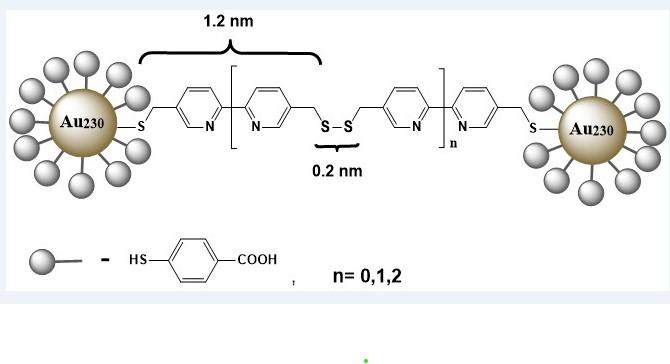High-precision imaging revealed what holds on the smallest light responsive gold chain

Suggested structure of two Au230 nanoclusters linked by 5,5?-bis(mercaptomethyl)-2,2?-bipyridine (BMM-BPy) dithiols. Credit: The University of Jyväskylä/Karolina Sokolowska
Manufacture of chemical sensors and catalysts based on gold nanoclusters gained new light from recent cutting-edge research. Chemists at the University of Jyväskylä, Finland and the University of California succeeded in determining the atomic precise structure of a chain of gold nanoclusters attached to each other. In this study the researchers revealed the disulfide-bridging bond between the bound nanoclusters. Linked gold nanocluster structures advance our understanding of the optical and electronic response of these systems which hold future perspectives in nanoelectronics and bioimaging. The study was published in The Journal of Physical Chemistry Letters publication in January 2020.
These structures – practically huge molecules- were studied four years ago by a researchers at the Nanoscience Center of the University of Jyväskylä. At that time, researchers were the first in the world to build a chains of gold forged with atomic precision, which were named the world's smallest gold chains (Nanoscale, 2016).
In a just released spatially resolved imaging study of individual bonds, researchers investigated the structure of the chain with the precision of atoms and provided experimental confirmation that, the gold nanoparticles are linked together by bridging disulfide bonds. The proof of disulfide linking was to date the subject of speculatithe researchers revealed the disulfide-bridging bond between the bound nanoclusters. Linked gold nanocluster structures advance our understanding of the optical and electronic response of these systems which hold future perspectives in nanoelectronics and bioimaging. The ston.
“Modifying the surface of nanoclusters and the molecules connecting them is a step closer to new biological, medical and electronic applications,” says Docent Tanja Lahtinen from the University of Jyväskylä.
A chain of nanoscale gold particles reacts with light.
“In these nanoscale superstructures, the electron clouds of the metal particles of adjacent particles are interconnected, opening up the possibility of studying the interactions between particles with very accurate theoretical calculations, now that we know, for sure, how the structures have formed,” says researcher Eero Hulkko.
The atomic precise structure was revealed by combining imaging techniques
The exploration of nanoscale chemical structures has promoted by the rapid development of chemically selective imaging techniques. Atomic resolution of individual molecules requires extremely high resolution and sensitivity of the equipment.
This study utilized the latest transmission electron microscopy technology (TEM).
The measurements were made at the IMRI center, University of California using the JEM-ARM300F Grand ARM TEM equipment, where currently has the best commercially available electron microscopy equipment.
“This study combined high-resolution electron microscopy (TEM) with high-sensitivity electron energy loss spectroscopy (EELS), which allowed simultaneous structural and spectroscopic analysis to determine the nanoscale structure, with X-ray photoelectron spectroscopy (XPS) analysis supported by the above-mentioned data.” review by researcher Karolina Sokolowska from the University of Jyväskylä.
###
This research was part of a research collaboration and researcher exchange with the Nanoscience Center (NSC) at the University of Jyväskylä and the Chemistry at the Space-Time Limit Center (CaSTL) at the University of California.
The study was conducted at the new IMRI (Irvine Materials Research Institute) Materials Research Center at the University of California, Irvine (UCI) campus.
Researchers included Karolina Sokolowska, Eero Hulkko and Docent Tanja Lahtinen from the University of Jyväskylä, Professor Ara Apkaria and Researcher Zhongyue Luan from the University of California, and Noelia Barrabés and Christoph Rameshan from the Technical University of Vienna.
Link to the research article: https:/
For further information:
Docent Tanja Lahtinen, tanja.m.lahtinen@jyu.fi, tel. +358 40 805 3697
Communications officer Tanja Heikkinen, tanja.s.heikkinen@jyu.fi, tel. +358 50 5818351
Media Contact
More Information:
http://dx.doi.org/10.1021/acs.jpclett.9b03496All latest news from the category: Life Sciences and Chemistry
Articles and reports from the Life Sciences and chemistry area deal with applied and basic research into modern biology, chemistry and human medicine.
Valuable information can be found on a range of life sciences fields including bacteriology, biochemistry, bionics, bioinformatics, biophysics, biotechnology, genetics, geobotany, human biology, marine biology, microbiology, molecular biology, cellular biology, zoology, bioinorganic chemistry, microchemistry and environmental chemistry.
Newest articles

First-of-its-kind study uses remote sensing to monitor plastic debris in rivers and lakes
Remote sensing creates a cost-effective solution to monitoring plastic pollution. A first-of-its-kind study from researchers at the University of Minnesota Twin Cities shows how remote sensing can help monitor and…

Laser-based artificial neuron mimics nerve cell functions at lightning speed
With a processing speed a billion times faster than nature, chip-based laser neuron could help advance AI tasks such as pattern recognition and sequence prediction. Researchers have developed a laser-based…

Optimising the processing of plastic waste
Just one look in the yellow bin reveals a colourful jumble of different types of plastic. However, the purer and more uniform plastic waste is, the easier it is to…



